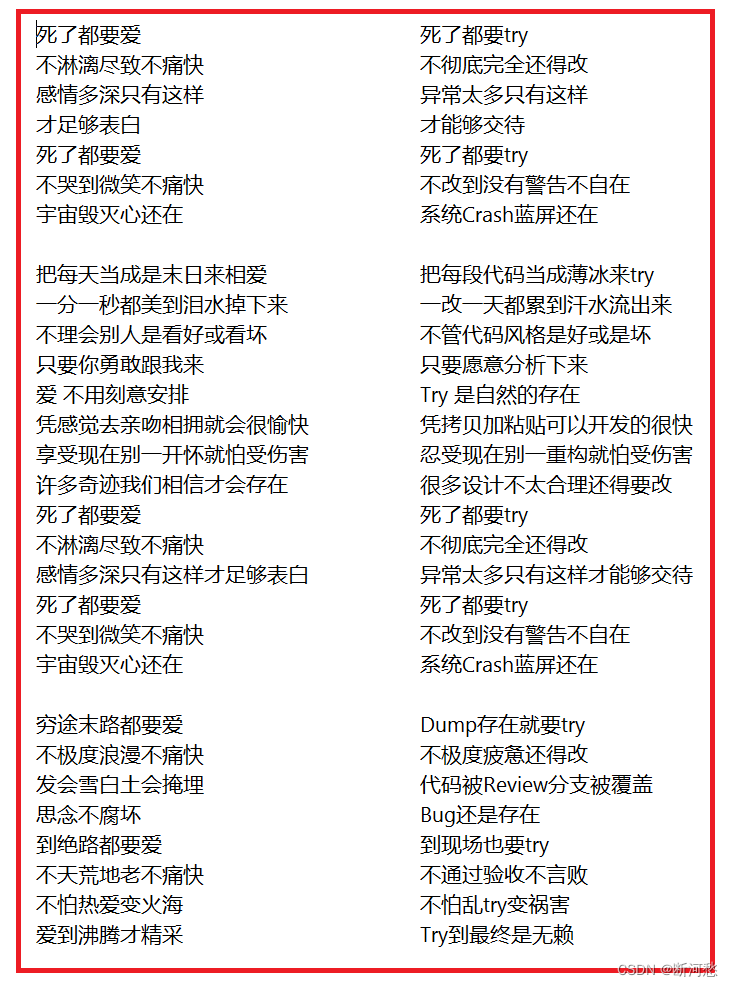第09章_异常处理

第09章_异常处理
讲师:尚硅谷-宋红康(江湖人称:康师傅)
官网:http://www.atguigu.com
本章专题与脉络
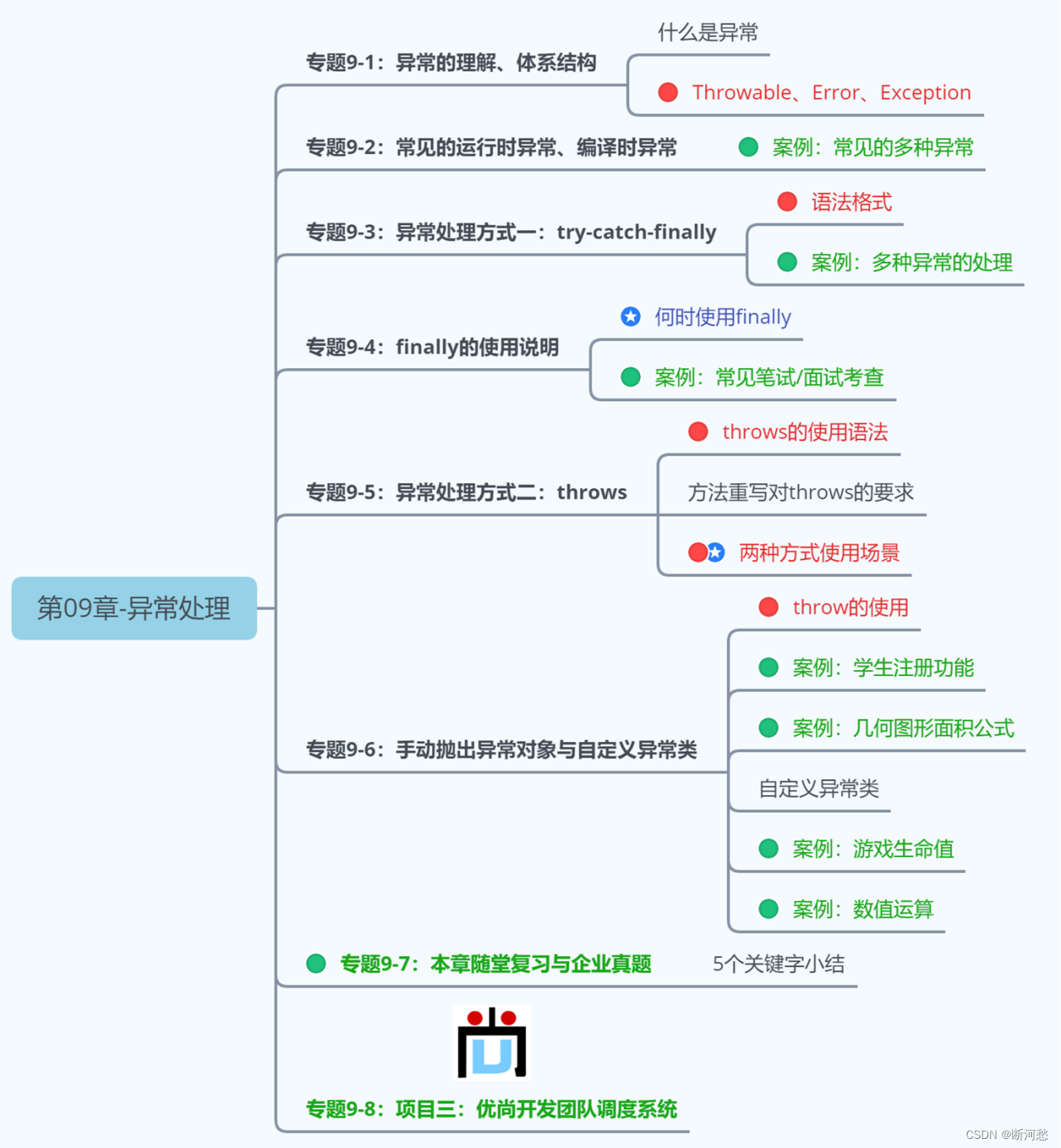
1. 异常概述
1.1 什么是生活的异常
男主角小明每天开车上班,正常车程1小时。但是,不出意外的话,可能会出现意外。

出现意外,即为异常情况。我们会做相应的处理。如果不处理,到不了公司。处理完了,就可以正常开车去公司。

1.2 什么是程序的异常
在使用计算机语言进行项目开发的过程中,即使程序员把代码写得尽善尽美,在系统的运行过程中仍然会遇到一些问题,因为很多问题不是靠代码能够避免的,比如:客户输入数据的格式问题,读取文件是否存在,网络是否始终保持通畅等等。
-
异常 :指的是程序在执行过程中,出现的非正常情况,如果不处理最终会导致JVM的非正常停止。
异常指的并不是语法错误和逻辑错误。语法错了,编译不通过,不会产生字节码文件,根本不能运行。
代码逻辑错误,只是没有得到想要的结果,例如:求a与b的和,你写成了a-b
1.3 异常的抛出机制
Java中是如何表示不同的异常情况,又是如何让程序员得知,并处理异常的呢?
Java中把不同的异常用不同的类表示,一旦发生某种异常,就创建该异常类型的对象,并且抛出(throw)。然后程序员可以捕获(catch)到这个异常对象,并处理;如果没有捕获(catch)这个异常对象,那么这个异常对象将会导致程序终止。
举例:
运行下面的程序,程序会产生一个数组角标越界异常ArrayIndexOfBoundsException。我们通过图解来解析下异常产生和抛出的过程。
public class ArrayTools {// 对给定的数组通过给定的角标获取元素。public static int getElement(int[] arr, int index) {int element = arr[index];return element;}
}
测试类
public class ExceptionDemo {public static void main(String[] args) {int[] arr = { 34, 12, 67 };intnum = ArrayTools.getElement(arr, 4)System.out.println("num=" + num);System.out.println("over");}
}
上述程序执行过程图解:
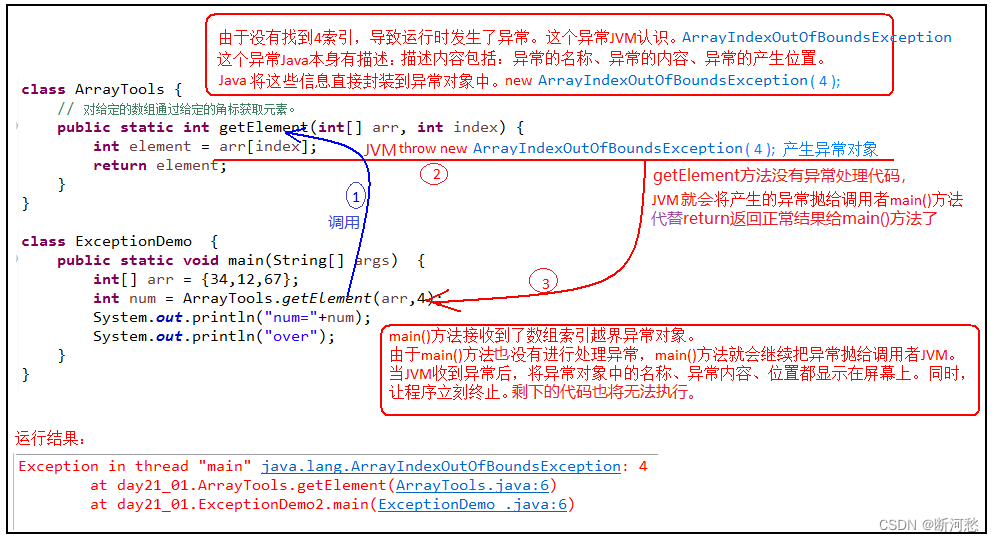
1.4 如何对待异常
对于程序出现的异常,一般有两种解决方法:一是遇到错误就终止程序的运行。另一种方法是程序员在编写程序时,就充分考虑到各种可能发生的异常和错误,极力预防和避免。实在无法避免的,要编写相应的代码进行异常的检测、以及异常的处理,保证代码的健壮性。
2. Java异常体系
2.1 Throwable
java.lang.Throwable 类是Java程序执行过程中发生的异常事件对应的类的根父类。
Throwable中的常用方法:
-
public void printStackTrace():打印异常的详细信息。包含了异常的类型、异常的原因、异常出现的位置、在开发和调试阶段都得使用printStackTrace。
-
public String getMessage():获取发生异常的原因。
2.2 Error 和 Exception
Throwable可分为两类:Error和Exception。分别对应着java.lang.Error与java.lang.Exception两个类。
Error:Java虚拟机无法解决的严重问题。如:JVM系统内部错误、资源耗尽等严重情况。一般不编写针对性的代码进行处理。
-
例如:StackOverflowError(栈内存溢出)和OutOfMemoryError(堆内存溢出,简称OOM)。
Exception: 其它因编程错误或偶然的外在因素导致的一般性问题,需要使用针对性的代码进行处理,使程序继续运行。否则一旦发生异常,程序也会挂掉。例如:
-
空指针访问
-
试图读取不存在的文件
-
网络连接中断
-
数组角标越界
说明:
无论是Error还是Exception,还有很多子类,异常的类型非常丰富。当代码运行出现异常时,特别是我们不熟悉的异常时,不要紧张,把异常的简单类名,拷贝到API中去查去认识它即可。
我们本章讲的异常处理,其实针对的就是Exception。
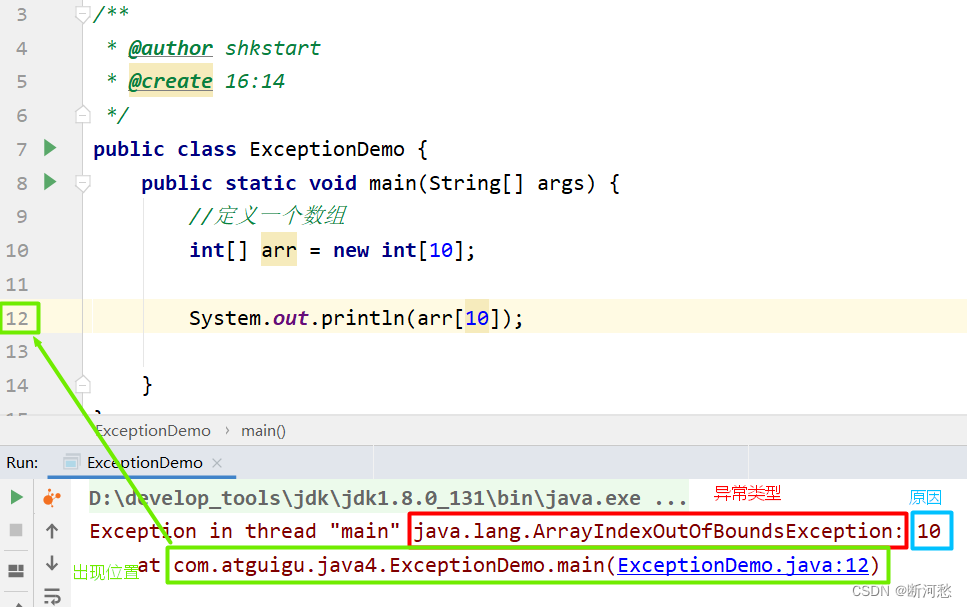
2.3 编译时异常和运行时异常
Java程序的执行分为编译时过程和运行时过程。有的错误只有在运行时才会发生。比如:除数为0,数组下标越界等。

因此,根据异常可能出现的阶段,可以将异常分为:
-
编译时期异常(即checked异常、受检异常):在代码编译阶段,编译器就能明确
警示当前代码可能发生(不是一定发生)xx异常,并明确督促程序员提前编写处理它的代码。如果程序员没有编写对应的异常处理代码,则编译器就会直接判定编译失败,从而不能生成字节码文件。通常,这类异常的发生不是由程序员的代码引起的,或者不是靠加简单判断就可以避免的,例如:FileNotFoundException(文件找不到异常)。 -
运行时期异常(即runtime异常、unchecked异常、非受检异常):在代码编译阶段,编译器完全不做任何检查,无论该异常是否会发生,编译器都不给出任何提示。只有等代码运行起来并确实发生了xx异常,它才能被发现。通常,这类异常是由程序员的代码编写不当引起的,只要稍加判断,或者细心检查就可以避免。
-
java.lang.RuntimeException类及它的子类都是运行时异常。比如:ArrayIndexOutOfBoundsException数组下标越界异常,ClassCastException类型转换异常。
-
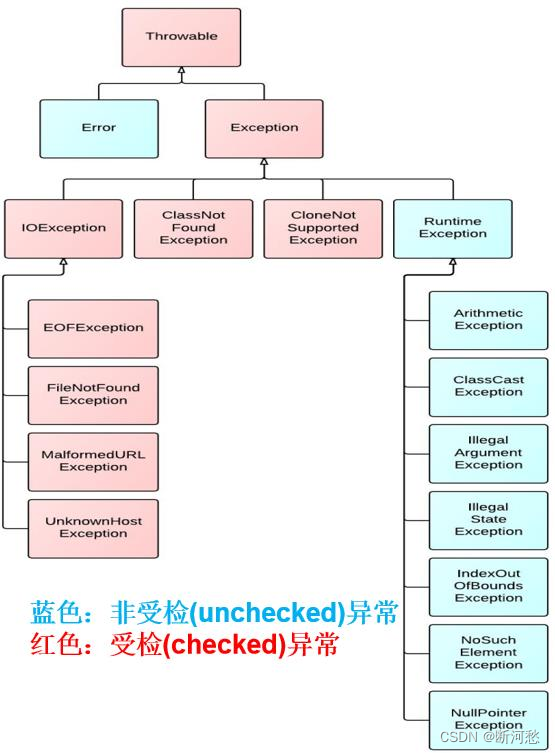
3. 常见的错误和异常
3.1 Error
最常见的就是VirtualMachineError,它有两个经典的子类:StackOverflowError、OutOfMemoryError。
package com.atguigu.exception;
import org.junit.Test;
public class TestStackOverflowError {@Testpublic void test01(){//StackOverflowErrorrecursion();}
public void recursion(){ //递归方法recursion(); }
}
package com.atguigu.exception;
import org.junit.Test;
public class TestOutOfMemoryError {@Testpublic void test02(){//OutOfMemoryError//方式一:int[] arr = new int[Integer.MAX_VALUE];}@Testpublic void test03(){//OutOfMemoryError//方式二:StringBuilder s = new StringBuilder();while(true){s.append("atguigu");}}
}
3.2 运行时异常
package com.atguigu.exception;
import org.junit.Test;
import java.util.Scanner;
public class TestRuntimeException {@Testpublic void test01(){//NullPointerExceptionint[][] arr = new int[3][];System.out.println(arr[0].length);}
@Testpublic void test02(){//ClassCastExceptionObject obj = 15;String str = (String) obj;}
@Testpublic void test03(){//ArrayIndexOutOfBoundsExceptionint[] arr = new int[5];for (int i = 1; i <= 5; i++) {System.out.println(arr[i]);}}
@Testpublic void test04(){//InputMismatchExceptionScanner input = new Scanner(System.in);System.out.print("请输入一个整数:");//输入非整数int num = input.nextInt();input.close();}
@Testpublic void test05(){int a = 1;int b = 0;//ArithmeticExceptionSystem.out.println(a/b);}
}
3.3 编译时异常
package com.atguigu.exception;
import org.junit.Test;
import java.io.FileInputStream;
import java.io.FileNotFoundException;
import java.sql.Connection;
import java.sql.DriverManager;
import java.sql.SQLException;
public class TestCheckedException {@Testpublic void test06() {Thread.sleep(1000);//休眠1秒 InterruptedException}
@Testpublic void test07(){Class c = Class.forName("java.lang.String");//ClassNotFoundException}
@Testpublic void test08() {Connection conn = DriverManager.getConnection("...."); //SQLException}@Testpublic void test09() {FileInputStream fis = new FileInputStream("尚硅谷Java秘籍.txt"); //FileNotFoundException}@Testpublic void test10() {File file = new File("尚硅谷Java秘籍.txt");FileInputStream fis = new FileInputStream(file);//FileNotFoundExceptionint b = fis.read();//IOExceptionwhile(b != -1){System.out.print((char)b);b = fis.read();//IOException}fis.close();//IOException}
}
4. 异常的处理
4.1 异常处理概述
在编写程序时,经常要在可能出现错误的地方加上检测的代码,如进行x/y运算时,要检测分母为0,数据为空,输入的不是数据而是字符等。过多的if-else分支会导致程序的代码加长、臃肿,可读性差,程序员需要花很大的精力“堵漏洞”。因此采用异常处理机制。
Java异常处理
Java采用的异常处理机制,是将异常处理的程序代码集中在一起,与正常的程序代码分开,使得程序简洁、优雅,并易于维护。
Java异常处理的方式:
方式一:try-catch-finally
方式二:throws + 异常类型

4.2 方式1:捕获异常(try-catch-finally)
Java提供了异常处理的抓抛模型。
-
前面提到,Java程序的执行过程中如出现异常,会生成一个异常类对象,该异常对象将被提交给Java运行时系统,这个过程称为
抛出(throw)异常。 -
如果一个方法内抛出异常,该异常对象会被抛给调用者方法中处理。如果异常没有在调用者方法中处理,它继续被抛给这个调用方法的上层方法。这个过程将一直继续下去,直到异常被处理。这一过程称为
捕获(catch)异常。 -
如果一个异常回到main()方法,并且main()也不处理,则程序运行终止。
4.2.1 try-catch-finally基本格式
捕获异常语法如下:
try{...... //可能产生异常的代码
}
catch( 异常类型1 e ){...... //当产生异常类型1型异常时的处置措施
}
catch( 异常类型2 e ){...... //当产生异常类型2型异常时的处置措施
}
finally{...... //无论是否发生异常,都无条件执行的语句
}
1、整体执行过程:
当某段代码可能发生异常,不管这个异常是编译时异常(受检异常)还是运行时异常(非受检异常),我们都可以使用try块将它括起来,并在try块下面编写catch分支尝试捕获对应的异常对象。
-
如果在程序运行时,try块中的代码没有发生异常,那么catch所有的分支都不执行。
-
如果在程序运行时,try块中的代码发生了异常,根据异常对象的类型,将从上到下选择第一个匹配的catch分支执行。此时try中发生异常的语句下面的代码将不执行,而整个try...catch之后的代码可以继续运行。
-
如果在程序运行时,try块中的代码发生了异常,但是所有catch分支都无法匹配(捕获)这个异常,那么JVM将会终止当前方法的执行,并把异常对象“抛”给调用者。如果调用者不处理,程序就挂了。
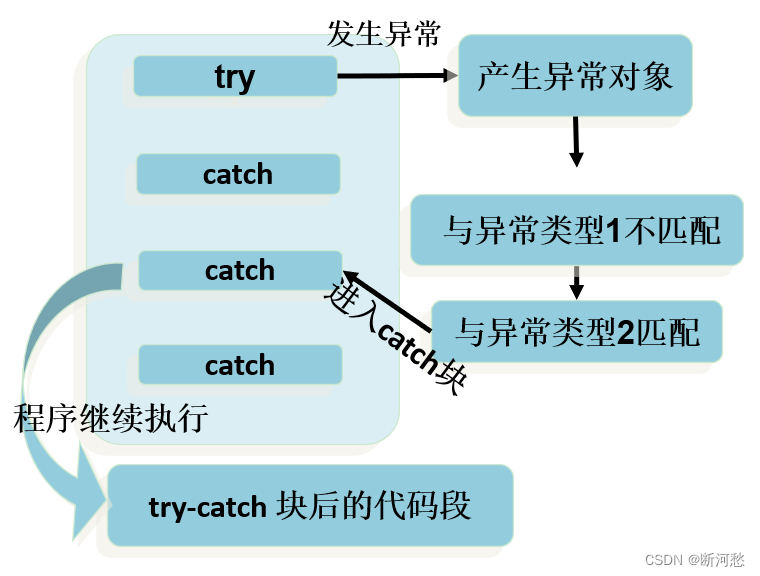
2、try
-
捕获异常的第一步是用
try{…}语句块选定捕获异常的范围,将可能出现异常的业务逻辑代码放在try语句块中。
3、catch (Exceptiontype e)
-
catch分支,分为两个部分,catch()中编写异常类型和异常参数名,{}中编写如果发生了这个异常,要做什么处理的代码。
-
如果明确知道产生的是何种异常,可以用该异常类作为catch的参数;也可以用其父类作为catch的参数。
比如:可以用ArithmeticException类作为参数的地方,就可以用RuntimeException类作为参数,或者用所有异常的父类Exception类作为参数。但不能是与ArithmeticException类无关的异常,如NullPointerException(catch中的语句将不会执行)。
-
每个try语句块可以伴随一个或多个catch语句,用于处理可能产生的不同类型的异常对象。
-
如果有多个catch分支,并且多个异常类型有父子类关系,必须保证小的子异常类型在上,大的父异常类型在下。否则,报错。
-
catch中常用异常处理的方式
-
public String getMessage():获取异常的描述信息,返回字符串 -
public void printStackTrace():打印异常的跟踪栈信息并输出到控制台。包含了异常的类型、异常的原因、还包括异常出现的位置,在开发和调试阶段,都得使用printStackTrace()。
-

4.2.2 使用举例
举例1:
public class IndexOutExp {public static void main(String[] args) {String friends[] = { "lisa", "bily", "kessy" };try {for (int i = 0; i < 5; i++) {System.out.println(friends[i]);}} catch (ArrayIndexOutOfBoundsException e) {System.out.println("index err");}System.out.println("\\nthis is the end");}
}
举例2:
public class DivideZero1 {int x;public static void main(String[] args) {int y;DivideZero1 c = new DivideZero1();try {y = 3 / c.x;} catch (ArithmeticException e) {System.out.println("divide by zero error!");}System.out.println("program ends ok!");}
}
举例3:
@Test
public void test1(){try{String str1 = "atguigu.com";str1 = null;System.out.println(str1.charAt(0));}catch(NullPointerException e){//异常的处理方式1System.out.println("不好意思,亲~出现了小问题,正在加紧解决..."); }catch(ClassCastException e){//异常的处理方式2System.out.println("出现了类型转换的异常");}catch(RuntimeException e){//异常的处理方式3System.out.println("出现了运行时异常");}//此处的代码,在异常被处理了以后,是可以正常执行的System.out.println("hello");
}
举例4:
4.2.3 finally使用及举例
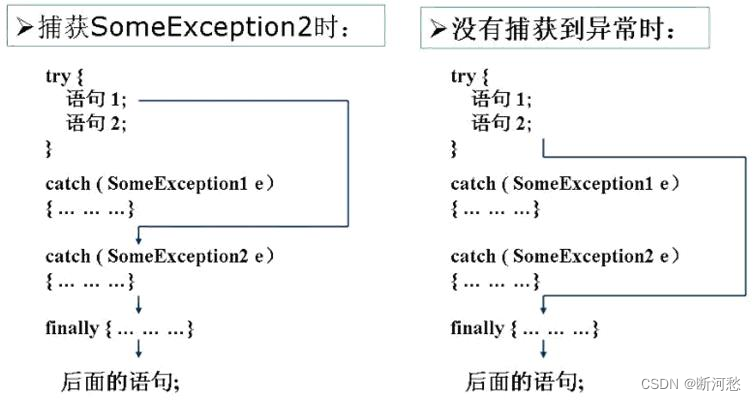
-
因为异常会引发程序跳转,从而会导致有些语句执行不到。而程序中有一些特定的代码无论异常是否发生,都
需要执行。例如,数据库连接、输入流输出流、Socket连接、Lock锁的关闭等,这样的代码通常就会放到finally块中。所以,我们通常将一定要被执行的代码声明在finally中。-
唯一的例外,使用 System.exit(0) 来终止当前正在运行的 Java 虚拟机。
-
-
不论在try代码块中是否发生了异常事件,catch语句是否执行,catch语句是否有异常,catch语句中是否有return,finally块中的语句都会被执行。
-
finally语句和catch语句是可选的,但finally不能单独使用。
try{}finally{}
举例1:确保资源关闭
package com.atguigu.keyword;import java.util.InputMismatchException;
import java.util.Scanner;public class TestFinally {public static void main(String[] args) {Scanner input = new Scanner(System.in);try {System.out.print("请输入第一个整数:");int a = input.nextInt();System.out.print("请输入第二个整数:");int b = input.nextInt();int result = a/b;System.out.println(a + "/" + b +"=" + result);} catch (InputMismatchException e) {System.out.println("数字格式不正确,请输入两个整数");}catch (ArithmeticException e){System.out.println("第二个整数不能为0");} finally {System.out.println("程序结束,释放资源");input.close();}}@Testpublic void test1(){FileInputStream fis = null;try{File file = new File("hello1.txt");fis = new FileInputStream(file);//FileNotFoundExceptionint b = fis.read();//IOExceptionwhile(b != -1){System.out.print((char)b);b = fis.read();//IOException}}catch(IOException e){e.printStackTrace();}finally{try {if(fis != null)fis.close();//IOException} catch (IOException e) {e.printStackTrace();} }}
}
举例2:从try回来
public class FinallyTest1 {public static void main(String[] args) {int result = test("12");System.out.println(result);}public static int test(String str){try{Integer.parseInt(str);return 1;}catch(NumberFormatException e){return -1;}finally{System.out.println("test结束");}}
}
举例3:从catch回来
public class FinallyTest2 {public static void main(String[] args) {int result = test("a");System.out.println(result);}public static int test(String str) {try {Integer.parseInt(str);return 1;} catch (NumberFormatException e) {return -1;} finally {System.out.println("test结束");}}
}
举例4:从finally回来
public class FinallyTest3 {public static void main(String[] args) {int result = test("a");System.out.println(result);}public static int test(String str) {try {Integer.parseInt(str);return 1;} catch (NumberFormatException e) {return -1;} finally {System.out.println("test结束");return 0;}}
}
笔试题:
public class ExceptionTest {public static void main(String[] args) {int result = test();System.out.println(result); //100}public static int test(){int i = 100;try {return i;} finally {i++;}}
}
笔试题:final、finally、finalize有什么区别?
4.2.4 练习
编写一个类ExceptionTest,在main方法中使用try、catch、finally,要求:
-
在try块中,编写被零除的代码。
-
在catch块中,捕获被零除所产生的异常,并且打印异常信息
-
在finally块中,打印一条语句。
4.2.5 异常处理的体会
-
前面使用的异常都是
RuntimeException类或是它的子类,这些类的异常的特点是:即使没有使用try和catch捕获,Java自己也能捕获,并且编译通过 ( 但运行时会发生异常使得程序运行终止 )。所以,对于这类异常,可以不作处理,因为这类异常很普遍,若全处理可能会对程序的可读性和运行效率产生影响。 -
如果抛出的异常是IOException等类型的
非运行时异常,则必须捕获,否则编译错误。也就是说,我们必须处理编译时异常,将异常进行捕捉,转化为运行时异常。
4.3 方式2:声明抛出异常类型(throws)
-
如果在编写方法体的代码时,某句代码可能发生某个
编译时异常,不处理编译不通过,但是在当前方法体中可能不适合处理或无法给出合理的处理方式,则此方法应显示地声明抛出异常,表明该方法将不对这些异常进行处理,而由该方法的调用者负责处理。
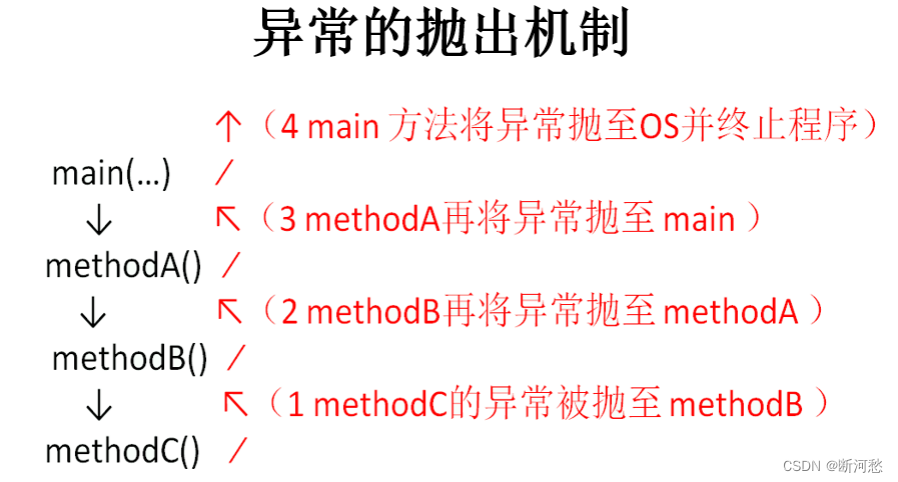
-
具体方式:在方法声明中用
throws语句可以声明抛出异常的列表,throws后面的异常类型可以是方法中产生的异常类型,也可以是它的父类。
4.3.1 throws基本格式
声明异常格式:
修饰符 返回值类型 方法名(参数) throws 异常类名1,异常类名2…{ }
在throws后面可以写多个异常类型,用逗号隔开。
举例:
public void readFile(String file) throws FileNotFoundException,IOException {...// 读文件的操作可能产生FileNotFoundException或IOException类型的异常FileInputStream fis = new FileInputStream(file);//...
}
4.3.2 throws 使用举例
举例:针对于编译时异常
package com.atguigu.keyword;public class TestThrowsCheckedException {public static void main(String[] args) {System.out.println("上课.....");try {afterClass();//换到这里处理异常} catch (InterruptedException e) {e.printStackTrace();System.out.println("准备提前上课");}System.out.println("上课.....");}public static void afterClass() throws InterruptedException {for(int i=10; i>=1; i--){Thread.sleep(1000);//本来应该在这里处理异常System.out.println("距离上课还有:" + i + "分钟");}}
}
举例:针对于运行时异常:
throws后面也可以写运行时异常类型,只是运行时异常类型,写或不写对于编译器和程序执行来说都没有任何区别。如果写了,唯一的区别就是调用者调用该方法后,使用try...catch结构时,IDEA可以获得更多的信息,需要添加哪种catch分支。
package com.atguigu.keyword;import java.util.InputMismatchException;
import java.util.Scanner;public class TestThrowsRuntimeException {public static void main(String[] args) {Scanner input = new Scanner(System.in);try {System.out.print("请输入第一个整数:");int a = input.nextInt();System.out.print("请输入第二个整数:");int b = input.nextInt();int result = divide(a,b);System.out.println(a + "/" + b +"=" + result);} catch (ArithmeticException | InputMismatchException e) {e.printStackTrace();} finally {input.close();}}public static int divide(int a, int b)throws ArithmeticException{return a/b;}
}
4.3.3 方法重写中throws的要求
方法重写时,对于方法签名是有严格要求的。复习:
(1)方法名必须相同 (2)形参列表必须相同 (3)返回值类型- 基本数据类型和void:必须相同- 引用数据类型:<= (4)权限修饰符:>=,而且要求父类被重写方法在子类中是可见的 (5)不能是static,final修饰的方法
此外,对于throws异常列表要求:
-
如果父类被重写方法的方法签名后面没有 “throws 编译时异常类型”,那么重写方法时,方法签名后面也不能出现“throws 编译时异常类型”。
-
如果父类被重写方法的方法签名后面有 “
throws 编译时异常类型”,那么重写方法时,throws的编译时异常类型必须 <= 被重写方法throws的编译时异常类型,或者不throws编译时异常。 -
方法重写,对于“
throws 运行时异常类型”没有要求。
package com.atguigu.keyword;import java.io.IOException;class Father{public void method()throws Exception{System.out.println("Father.method");}
}
class Son extends Father{@Overridepublic void method() throws IOException,ClassCastException {System.out.println("Son.method");}
}
4.4 两种异常处理方式的选择
前提:对于异常,使用相应的处理方式。此时的异常,主要指的是编译时异常。
-
如果程序代码中,涉及到资源的调用(流、数据库连接、网络连接等),则必须考虑使用try-catch-finally来处理,保证不出现内存泄漏。
-
如果父类被重写的方法没有throws异常类型,则子类重写的方法中如果出现异常,只能考虑使用try-catch-finally进行处理,不能throws。
-
开发中,方法a中依次调用了方法b,c,d等方法,方法b,c,d之间是递进关系。此时,如果方法b,c,d中有异常,我们通常选择使用throws,而方法a中通常选择使用try-catch-finally。
5. 手动抛出异常对象:throw
Java 中异常对象的生成有两种方式:
-
由虚拟机自动生成:程序运行过程中,虚拟机检测到程序发生了问题,那么针对当前代码,就会在后台自动创建一个对应异常类的实例对象并抛出。
-
由开发人员手动创建:
new 异常类型([实参列表]);,如果创建好的异常对象不抛出对程序没有任何影响,和创建一个普通对象一样,但是一旦throw抛出,就会对程序运行产生影响了。
5.1 使用格式
throw new 异常类名(参数);
throw语句抛出的异常对象,和JVM自动创建和抛出的异常对象一样。
-
如果是编译时异常类型的对象,同样需要使用throws或者try...catch处理,否则编译不通过。
-
如果是运行时异常类型的对象,编译器不提示。
-
可以抛出的异常必须是Throwable或其子类的实例。下面的语句在编译时将会产生语法错误:
throw new String("want to throw");
5.2 使用注意点:
无论是编译时异常类型的对象,还是运行时异常类型的对象,如果没有被try..catch合理的处理,都会导致程序崩溃。
throw语句会导致程序执行流程被改变,throw语句是明确抛出一个异常对象,因此它下面的代码将不会执行。
如果当前方法没有try...catch处理这个异常对象,throw语句就会代替return语句提前终止当前方法的执行,并返回一个异常对象给调用者。
package com.atguigu.keyword;public class TestThrow {public static void main(String[] args) {try {System.out.println(max(4,2,31,1));} catch (Exception e) {e.printStackTrace();}try {System.out.println(max(4));} catch (Exception e) {e.printStackTrace();}try {System.out.println(max());} catch (Exception e) {e.printStackTrace();}}public static int max(int... nums){if(nums == null || nums.length==0){throw new IllegalArgumentException("没有传入任何整数,无法获取最大值");}int max = nums[0];for (int i = 1; i < nums.length; i++) {if(nums[i] > max){max = nums[i];}}return max;}
}
6. 自定义异常
6.1 为什么需要自定义异常类
Java中不同的异常类,分别表示着某一种具体的异常情况。那么在开发中总是有些异常情况是核心类库中没有定义好的,此时我们需要根据自己业务的异常情况来定义异常类。例如年龄负数问题,考试成绩负数问题,某员工已在团队中等。
6.2 如何自定义异常类
(1)要继承一个异常类型
自定义一个编译时异常类型:自定义类继承java.lang.Exception。
自定义一个运行时异常类型:自定义类继承java.lang.RuntimeException。
(2)建议大家提供至少两个构造器,一个是无参构造,一个是(String message)构造器。
(3)自定义异常需要提供serialVersionUID
6.3 注意点
-
自定义的异常只能通过throw抛出。
-
自定义异常最重要的是异常类的名字和message属性。当异常出现时,可以根据名字判断异常类型。比如:
TeamException("成员已满,无法添加");、TeamException("该员工已是某团队成员"); -
自定义异常对象只能手动抛出。抛出后由try..catch处理,也可以甩锅throws给调用者处理。
6.4 举例
举例1:
class MyException extends Exception {static final long serialVersionUID = 23423423435L;private int idnumber;public MyException(String message, int id) {super(message);this.idnumber = id;}public int getId() {return idnumber;}
}
public class MyExpTest {public void regist(int num) throws MyException {if (num < 0)throw new MyException("人数为负值,不合理", 3);elseSystem.out.println("登记人数" + num);}public void manager() {try {regist(100);} catch (MyException e) {System.out.print("登记失败,出错种类" + e.getId());}System.out.print("本次登记操作结束");}public static void main(String args[]) {MyExpTest t = new MyExpTest();t.manager();}
}
举例2:
package com.atguigu.define;
//自定义异常:
public class NotTriangleException extends Exception{static final long serialVersionUID = 13465653435L;public NotTriangleException() {}public NotTriangleException(String message) {super(message);}
}
package com.atguigu.define;public class Triangle {private double a;private double b;private double c;public Triangle(double a, double b, double c) throws NotTriangleException {if(a<=0 || b<=0 || c<=0){throw new NotTriangleException("三角形的边长必须是正数");}if(a+b<=c || b+c<=a || a+c<=b){throw new NotTriangleException(a+"," + b +"," + c +"不能构造三角形,三角形任意两边之后必须大于第三边");}this.a = a;this.b = b;this.c = c;}public double getA() {return a;}public void setA(double a) throws NotTriangleException{if(a<=0){throw new NotTriangleException("三角形的边长必须是正数");}if(a+b<=c || b+c<=a || a+c<=b){throw new NotTriangleException(a+"," + b +"," + c +"不能构造三角形,三角形任意两边之后必须大于第三边");}this.a = a;}public double getB() {return b;}public void setB(double b) throws NotTriangleException {if(b<=0){throw new NotTriangleException("三角形的边长必须是正数");}if(a+b<=c || b+c<=a || a+c<=b){throw new NotTriangleException(a+"," + b +"," + c +"不能构造三角形,三角形任意两边之后必须大于第三边");}this.b = b;}public double getC() {return c;}public void setC(double c) throws NotTriangleException {if(c<=0){throw new NotTriangleException("三角形的边长必须是正数");}if(a+b<=c || b+c<=a || a+c<=b){throw new NotTriangleException(a+"," + b +"," + c +"不能构造三角形,三角形任意两边之后必须大于第三边");}this.c = c;}@Overridepublic String toString() {return "Triangle{" +"a=" + a +", b=" + b +", c=" + c +'}';}
}
package com.atguigu.define;public class TestTriangle {public static void main(String[] args) {Triangle t = null;try {t = new Triangle(2,2,3);System.out.println("三角形创建成功:");System.out.println(t);} catch (NotTriangleException e) {System.err.println("三角形创建失败");e.printStackTrace();}try {if(t != null) {t.setA(1);}System.out.println("三角形边长修改成功");} catch (NotTriangleException e) {System.out.println("三角形边长修改失败");e.printStackTrace();}}
}
7. 练习
练习1:
public class ReturnExceptionDemo {static void methodA() {try {System.out.println("进入方法A");throw new RuntimeException("制造异常");}finally {System.out.println("用A方法的finally");}}static void methodB() {try {System.out.println("进入方法B");return;} finally {System.out.println("调用B方法的finally");}}public static void main(String[] args) {try {methodA();} catch (Exception e) {System.out.println(e.getMessage());}methodB();}
}
练习2:
从键盘接收学生成绩,成绩必须在0~100之间。
自定义成绩无效异常。
编写方法接收成绩并返回该成绩,如果输入无效,则抛出自定义异常。
练习3:
编写应用程序EcmDef.java,接收命令行的两个参数,要求不能输入负数,计算两数相除。 对数据类型不一致(NumberFormatException)、缺少命令行参数(ArrayIndexOutOfBoundsException、 除0(ArithmeticException)及输入负数(EcDef 自定义的异常)进行异常处理。
提示: (1)在主类(EcmDef)中定义异常方法(ecm)完成两数相除功能。
(2)在main()方法中使用异常处理语句进行异常处理。
(3)在程序中,自定义对应输入负数的异常类(EcDef)。
(4)运行时接受参数 java EcmDef 20 10 //args[0]=“20” args[1]=“10”
(5)Interger类的static方法parseInt(String s)将s转换成对应的int值。 如:int a=Interger.parseInt(“314”); //a=314;
8. 小结与小悟
8.1 小结:异常处理5个关键字
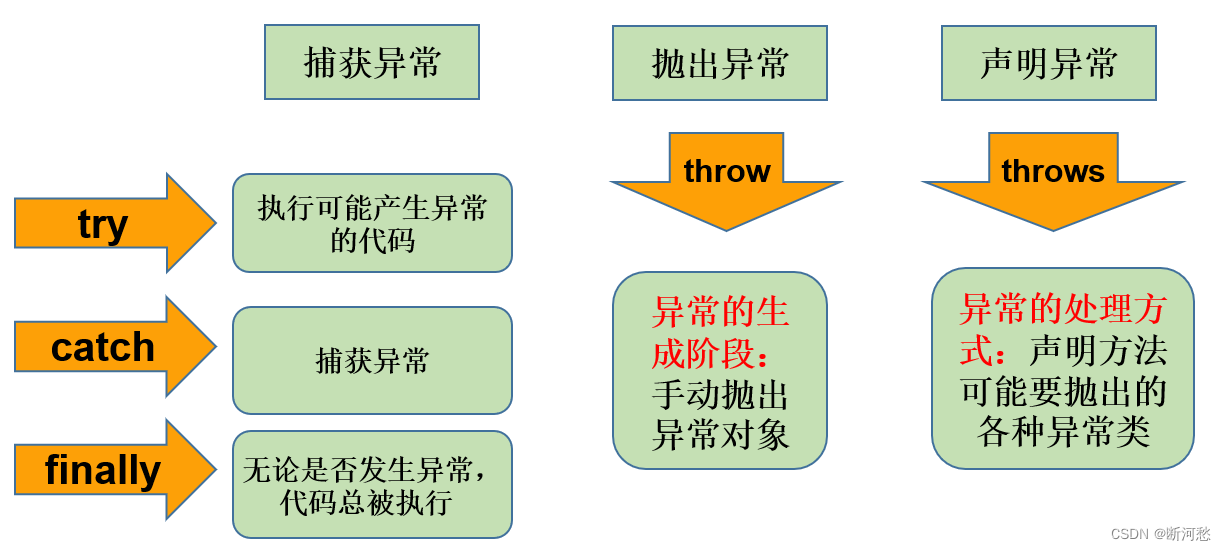
类比:上游排污,下游治污
8.2 感悟
小哲理:
世界上最遥远的距离,是我在if里你在else里,似乎一直相伴又永远分离;
世界上最痴心的等待,是我当case你是switch,或许永远都选不上自己;
世界上最真情的相依,是你在try我在catch。无论你发神马脾气,我都默默承受,静静处理。到那时,再来期待我们的finally。
歌词:

